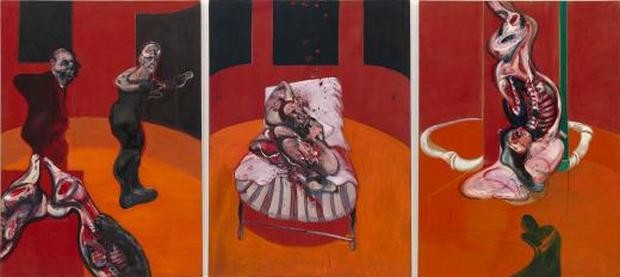Francis Bacon
From Picasso To Velázquez
30 Sep 2016 - 08 Jan 2017

Francis Bacon, Three Studies for a Crucifixion, 1962
Oil on canvas, three panels, 198.1 x 144.8 cm, each panel
Solomon R. Guggenheim Museum, New York, 64.1700
© The Estate of Francis Bacon. All rights reserved. DACS/VEGAP. Bilbao, 2016
Oil on canvas, three panels, 198.1 x 144.8 cm, each panel
Solomon R. Guggenheim Museum, New York, 64.1700
© The Estate of Francis Bacon. All rights reserved. DACS/VEGAP. Bilbao, 2016
FRANCIS BACON
From Picasso To Velázquez
30 September 2016 – 8 January 2017
Francis Bacon: From Picasso to Velázquez shows a selection of 50 paintings which are among the most important, attractive ones by Francis Bacon (b. 1909, Dublin; d. 1992, Madrid), along with around 30 works by some of the classical and modern masters who influenced Bacon’s career. The exhibition, which includes many of Bacon’s works that have rarely been exhibited in public before, seeks to more deeply explore the imprint that French and Spanish cultures left on the output of this artist who had been born in Ireland, was a fervent Francophile, and became a connoisseur of the art of the great Spanish masters, like Velázquez. Bacon started as a painter after visiting the exhibition Cent dessins par Picasso at the Paul Rosenberg Gallery in Paris. Keenly interested in French literature, he was an avid reader of Racine, Balzac, Baudelaire, and Proust and was passionate about the art of painters working in France, including Manet, Degas, Gauguin, Van Gogh, Seurat, Matisse, and Picasso, as well as other French artists from previous periods, such as Ingres, Géricault, and Daumier.
Beyond his first encounters with Picasso’s works in Paris in the 1920s and 1930s, his relationship with Spanish culture was primarily manifested in his obsession with Velázquez’s 1650 work Portrait of Pope Innocent X. Even though Bacon had had the chance to view the work directly in the Doria Pamphilj Gallery on a trip to Rome in 1954, he preferred to keep reproductions of painting in his memory, instead of the original, to create more than 50 works about this motif. In addition to Velázquez, Bacon was also fascinated by other classical masters, including Zurbarán, El Greco, and Goya, whose paintings he was able to see in Madrid’s Museo del Prado.
Organized by the Guggenheim Museum Bilbao in collaboration with Grimaldi Forum Monaco
From Picasso To Velázquez
30 September 2016 – 8 January 2017
Francis Bacon: From Picasso to Velázquez shows a selection of 50 paintings which are among the most important, attractive ones by Francis Bacon (b. 1909, Dublin; d. 1992, Madrid), along with around 30 works by some of the classical and modern masters who influenced Bacon’s career. The exhibition, which includes many of Bacon’s works that have rarely been exhibited in public before, seeks to more deeply explore the imprint that French and Spanish cultures left on the output of this artist who had been born in Ireland, was a fervent Francophile, and became a connoisseur of the art of the great Spanish masters, like Velázquez. Bacon started as a painter after visiting the exhibition Cent dessins par Picasso at the Paul Rosenberg Gallery in Paris. Keenly interested in French literature, he was an avid reader of Racine, Balzac, Baudelaire, and Proust and was passionate about the art of painters working in France, including Manet, Degas, Gauguin, Van Gogh, Seurat, Matisse, and Picasso, as well as other French artists from previous periods, such as Ingres, Géricault, and Daumier.
Beyond his first encounters with Picasso’s works in Paris in the 1920s and 1930s, his relationship with Spanish culture was primarily manifested in his obsession with Velázquez’s 1650 work Portrait of Pope Innocent X. Even though Bacon had had the chance to view the work directly in the Doria Pamphilj Gallery on a trip to Rome in 1954, he preferred to keep reproductions of painting in his memory, instead of the original, to create more than 50 works about this motif. In addition to Velázquez, Bacon was also fascinated by other classical masters, including Zurbarán, El Greco, and Goya, whose paintings he was able to see in Madrid’s Museo del Prado.
Organized by the Guggenheim Museum Bilbao in collaboration with Grimaldi Forum Monaco
